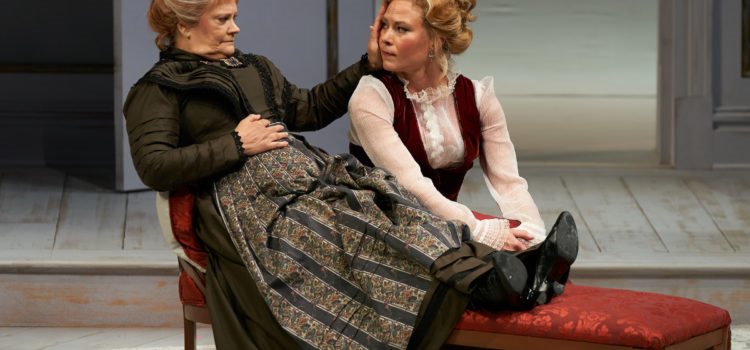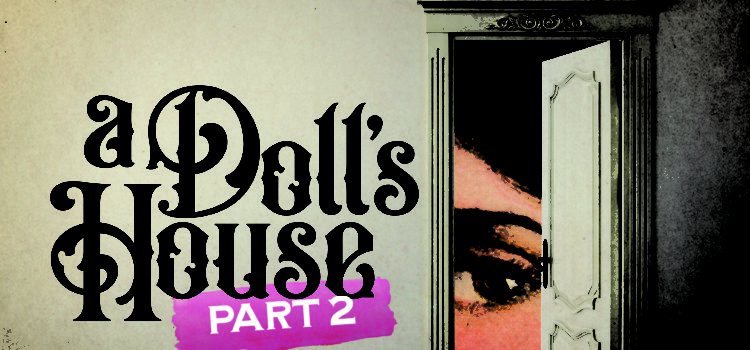By Andrea Braun
Contributing Writer
It’s difficult to see Nora Helmer, protagonist of A Doll’s House by Henrik Ibsen, in a positive light, not because she left her controlling husband, Torvald, back in 1879, but that she abandoned her three young children in the process. At least there was a reason for it. Like Nora, the children belonged to Torvald, just as much as his house or his clothes. He has help too. Nora had a loving nanny, Anne Marie, in fact, the very one who had abandoned her own child to raise Nora, so she knew her kids were in good hands.
Considering, then, that Nora had to choose between freedom for herself or staying with her entire family, her choice to go away can be justified, at least to an extent. In Ibsen’s play, she believes that her husband is controlling and the eight years they’ve been together haven’t changed him. She even feels at times as if she’s losing her mind. Contemporaneous audiences and critics couldn’t summon up sympathy for this bird in a gilded cage, but to 21st century minds, her actions weren’t unforgivable. Then along comes Lucas Hnath with A Doll’s House, Part 2, with a fresh take on the character.
Hnath uses a modern idiom to demystify the antiquated language and make it easier for us to just sit back and appreciate the comedy and drama happening before us. The first character to appear is Anne Marie (Tina Johnson) when she hobbles out to answer the door, yes, THAT door, located prominently upstage center. She’s not entirely surprised to see Nora (Caralyn Koslowski) after 15 years because Nora let her know she’d be coming, but not when.
We learn that the years haven’t been kind to Anne Marie, at least not physically, but Nora looks and sounds terrific. She darts about the room, finally perching on an ottoman, to catch Anne Marie up on what’s happened. Apparently, she has found success writing about women like herself under a pseudonym, since authors are “supposed” to be male. The drab set has furniture piled in a corner with a few pieces still in place around the room. When a chair is wanted, someone, more often than not, Nora, fetches one from the pile. Anne Marie’s costume is as gray as her surroundings, but Nora is dressed in vivid blue and red. Her plumage is a vibrant contrast to once well-ordered house. We get the impression that the mess represents Torvald’s current faux bachelor life.
Michael James Reed as Torvald. Photo by Peter Wochniak, ProPhotoSTL.comNora’s constant motion does remind me of the terms of endearment Torvald used to use for her when they lived together, which she hated. These were references to pet birds mostly, that flit from place to place while having no practical use other than ornamentation. Nora has a long speech shortly after coming on the scene about her life as it is now. She intends to see Torvald (Michael James Reed) the following day, he shows up unexpectedly and is extremely startled, in a Victorian sort of way, to see his wife returned at last. Having learned she’s not his ex-wife, as she thought she’d be, she has come to ask him to file the divorce papers. Nora can’t legally dissolve their bond without difficulty, but he can. And if he doesn’t, then presenting herself as unmarried for purposes of work and love affairs may constitute fraud.
At last, we begin to hear Torvald’s side of the story, but he has to get back to work. He returns later to continue the conversation. Nora solicits Anne Marie’s help in figuring out what to do, and Anne Marie suggests Nora speak to her daughter, Emmy (Andrea Abello). The older woman believes if Emmy asks Torvald to divorce her mother, he will do it. Enter Emmy. Emmy is not what her mother expects her to be. The younger woman has entirely different ideas about what constitutes a proper and happy life, while Nora learns that you do reap what you sow.
Caralyn Koszlowski is Nora, Andrea Abello is Emmy Peter Wochniak, ProPhotoSTL.comTimothy Near directs her first show at the Rep in several years, and she shows why she keeps being asked back. She keeps the action moving at warp speed when Nora’s around, but Anne Marie, and even Torvald, provide a calmer counterpoint. I do have a problem with a choice she made near the very end, but otherwise, Near gives us lovely work. Scott C. Neale’s set is cleverly conceived, and facilitates a lot of the movement onstage. And, of course, there’s that door which we now know lets people out, but also back in. Lighting designer Ann G. Wrightson’s work enhances the overall look. Rusty Wandall’s sound design is fun, peppered with songs that assert women’s power like “It’s Too Late,” “You Don’t Own Me,” and most prescient, “The Woman in Your Life (is You).”
Re-imagining a character such as Nora, far from the “Angel in the House” of her husband’s fantasies, but a woman who insists on being validated, judging her on her own merits and flaws, is illuminating. A Doll’s House, Part 2 provides a deeper examination of what’s going on with her, shows how her actions may have affected one of her children, and, at long last, lets us hear from Torvald. The play got a slew of awards and nominations; it deserves them.
‘A Doll’s House, Part 2’ is at the Repertory Theatre of St. Louis Oct. 12 through Nov. 4. Visit www.repstl.org for more information.
Photos by Peter Wochniak, ProPhotoSTL.com

Lynn (Zipfel) Venhaus has had a continuous byline in St. Louis metro region publications since 1978. She writes features and news for Belleville News-Democrat and contributes to St. Louis magazine and other publications.
She is a Rotten Tomatoes-approved film critic, currently reviews films for Webster-Kirkwood Times and KTRS Radio, covers entertainment for PopLifeSTL.com and co-hosts podcast PopLifeSTL.com…Presents.
She is a member of Critics Choice Association, where she serves on the women’s and marketing committees; Alliance of Women Film Journalists; and on the board of the St. Louis Film Critics Association. She is a founding and board member of the St. Louis Theater Circle.
She is retired from teaching journalism/media as an adjunct college instructor.


